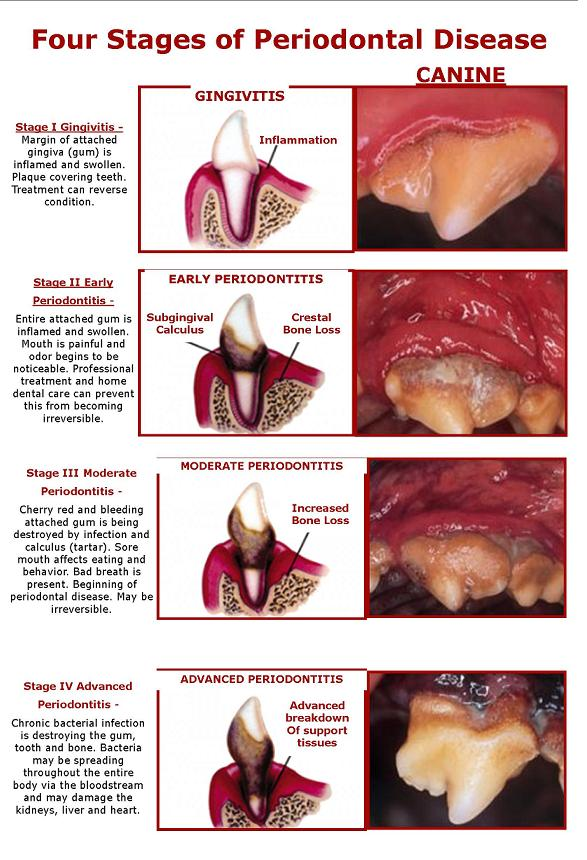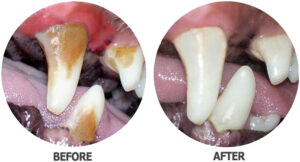Routine Dental Procedures
Dental Disease
Dental disease is one of the most common medical conditions seen by veterinarians. Over 80% of dogs over the age of three have active dental disease and more than half of all cats over the age of three have some form of dental disease.
The most common dental problems seen in dogs are Periodontal disease and fractured teeth while in cats the most common problems are gingivitis, periodontal disease (a progression from gingivitis), and tooth resorption.
- Periodontal disease is a term used to describe the infection and associated inflammation of the periodontium (the tissues surrounding the tooth).
- Gingivitis is an inflammation of the gums caused by the accumulation of plaque.
- Tooth resorption is a progressive destruction of the tooth (crown and/or root) resulting in slowly progressive “holes” in the affected teeth.

Dental Procedures
Unlike in human dentistry where fillings are used; in pets, the effective treatment is to extract the tooth to ensure that the disease does not spread. Even if teeth can be saved, they will inevitably degrade and need removing in the future.
The first step in your pet’s dental care is a dental exam to confirm that a dental cleaning is needed. Your veterinarian will review with you what procedures are likely required prior to the dental cleaning.
A preanesthetic blood tests will be performed to ensure that kidney and liver function are satisfactory for anaesthesia as well as an evaluation of the heart and abdomen if needed. Anaesthesia is important to allow a tooth-by-tooth examination including dental X-rays.
- A dental cleaning visit will include a thorough dental examination, dental radiographs (X-rays) may be taken to assess the viability of the tooth root and surrounding bone.
- Then tooth scaling will be performed, using both hand and ultrasonic scalers to remove plaque and tartar above and below the gum line. The tartar below the gum line causes the most significant periodontal disease, so it is important that it be thoroughly removed.
- After scaling, the teeth are polished to remove microscopic scratches and decrease the rate of subsequent plaque build-up.
When periodontal disease is advanced, it may not be possible to save the badly affected teeth, which may need to be extracted either during the procedure or at a later time.
Since it can be difficult to predict the extent of dental disease in advance of the procedure, it is imperative that your veterinarian be able to reach you during the procedure to discuss any additional treatment that may be necessary.
The treatment your pet may require will be discussed with you after the cleaning once each tooth and the gums have been checked.

Prevention
The best way to prevent dental disease is to reduce the rate at which plaque and tartar builds up on the teeth. A home dental care program including regular tooth brushing is a must. However, once tartar has formed; professional scaling and polishing under general anaesthesia will be needed as it cannot easily be removed by diets and/or brushing.
Use a cotton bud or pet tooth brush to apply toothpaste
Pet toothpastes are non-foaming, safe to be swallowed, and are available in flavours that are appealing to pets including poultry, beef, malt and mint. If you use a product that tastes good, your pet will be more likely to enjoy the whole experience. In addition to the pleasant taste, many of these toothpastes contain enzymes that are designed to help break down plaque chemically, which reduces the time you need to actually spend brushing your pet’s teeth.
Recent advances in pet nutrition have resulted in the development of water additives, treats, and diets that can reduce tartar accumulation. The Veterinary Oral Health Council seal of acceptance (VOHC.org) will only be found on products which have been shown to reduce the accumulation of plaque and/or tartar. Please look for this seal when choosing oral homecare products for your cat.
We recommend Hill’s Prescription Diet t/d® dry food, Hill’s Vet Essentials Dental Health® and Royal Canin Dental® dry food which are all regularly stocked and readily available at our hospital.
Do not use human toothpaste. Human teeth cleaning detergents contain ingredients that are not intended to be swallowed and can cause internal problems if they are swallowed. Human products also commonly contain higher levels of salt which can be a problem for some pets.
You should also avoid using baking soda to clean your pet’s teeth. Baking soda has a high alkaline content and, if swallowed, it can upset the acid balance in the stomach and digestive tract.

